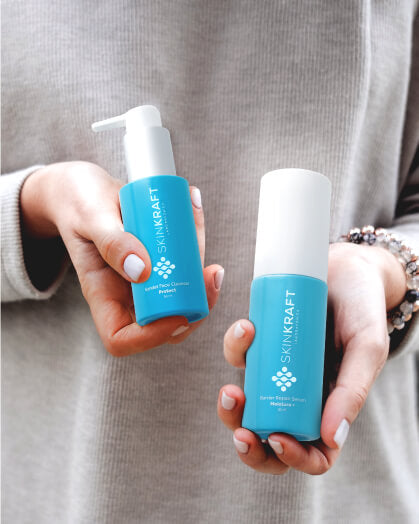Understanding Skin

SKIN ANATOMY & PHYSIOLOGY
Your skin is the largest organ in your body. It’s health and surface appearance is determined by your environment, your daily skin care routine, and the functioning of the various components that comprise the hidden layers under your skin’s surface.
Normal Skin
Normal skin is neither too oily nor too dry. The distinctive features of normal skin are:
- Balanced moisture and sebum content
- Smooth texture and a fine surface, with barely visible pores
- Skin may feel slightly greasy at the forehead and at the bridge of the nose, but retains sufficient moisture and sebum for skin hydration
- Normal skin is accompanied by a natural glow, indicating healthy blood circulation
Understanding Normal Skin:
Epidermis: The epidermis sheds at a normal rate. Melanocytes produce a balanced amount of pigment.
Sebaceous Glands: Sebaceous glands secrete enough oil to hydrate skin without oiliness.
Sebum: This oil hydrates the skin and forms a protective film.

Oily Skin
Oily skin is identified by an overproduction of skin oils by the sebaceous glands. The distinctive features of oily skin are:
- A layer of sheen, often with enlarged pores
- Being more prone to blackheads and blemishes as compared to other skin types
Understanding Oily Skin:
Epidermis: The uppermost layer thickens, causing cells to stick together and clog pores.
Sebaceous Glands: Sebaceous glands are enlarged due to overproduction of oil.
Sebum: An abundance of sebum lends a shiny or greasy appearance to the skin.

Dry Skin
Dry skin is characterized by a lack of moisture, resulting in dryness and flaking. The distinctive features of dry skin are:
- Dullness, especially on the cheeks and around the eyes
- Lack of elasticity, resulting in accentuated fine lines, wrinkles and other signs of premature ageing
- Extremely dry skin shows signs of cracking and fissuring
- Dry skin can be genetically determined or triggered by climate, harsh cosmetics and skin care
Understanding Dry Skin:
Epidermis: The uppermost layer is thin and jagged due to lack of hydration. Cells shed inefficiently, sticking to each other.
Sebaceous Glands: Oil glands do not produce enough out to lubricate the skin.
Sebum: A lack of sebum compromises the skin's barrier and leads to dryness.

Sensitive Skin
Sensitive skin is identified by high subjective sensitivity. The distinctive features of sensitive skin are:
- Low tolerance to skin care and personal care products
- Subjective symptoms such as stinging, itching and burning
Understanding Sensitive Skin:
Epidermis: The skin's surface is red and uncomfortable. Nerve endings are inflamed.
Dermis: Nerve endings are inflamed.


Acne
Acne is an inflammatory skin condition that causes spots and pimples. Fast Facts on Acne:
- Acne occur when hair follicles are clogged with dead skin cells and excess sebum
- Whiteheads, blackheads, cysts and nodules are all types of acne
- Can leave behind acne scars and blemishes
Understanding Acne:
Epidermis: Internal cell shedding (desquamation) leads to clogged pores
Sebaceous Glands: Sebaceous Glands are enlarged due to overproduction of oil
Sebum: Overproduction of sebum clogs hair follicles along with dead skin cells and debris

Dark Patches
Dark Patches cause dark, discoloured patterns on skin. Fast Facts on Dark Patches:
- Inflammations on skin can cause dark patches, especially after acne infections
- UV light exposure, tanning and chemicals in medication can cause dark patches
- Dark patches affect skin, regardless of any skin tone or race
Understanding Dark Patches:
Epidermis: Melanocytes overproduce melanin (skin's natural pigment) at the bottom of the epidermis. The overproduced melanin is transferred to the visible layers that leads to dark spots on the skin's surface

Dark Spots
Dark Spots are a result of overproduction of melanin (skin's natural pigment). Fast Facts on Dark Spots:
- They are also known as hyperpigmentation or age spots
- UV light exposure, tanning, aging are all causes of dark spots
- Dark Spots do not hurt neither do they affect the texture of skin
Understanding Dark Spots:
Epidermis: Melanocytes overproduce melanin at the bottom of the epidermis. The overproduced melanin is transferred to the visible layers that leads to dark spots on the skin's surface

Tan
Tanning is skin's defence mechanism from harmful UV rays. Fast Facts on Tan:
- Immediate Pigment Darkening and Delayed Pigment Darkening are the two types of tanning response to UV rays
Understanding Tan
Epidermis: Melanocytes overproduce melanin (skin's natural pigment) at the bottom of the epidermis. The overproduced melanin is transferred to the visible layers that leads to dark spots on the skin's surface
















